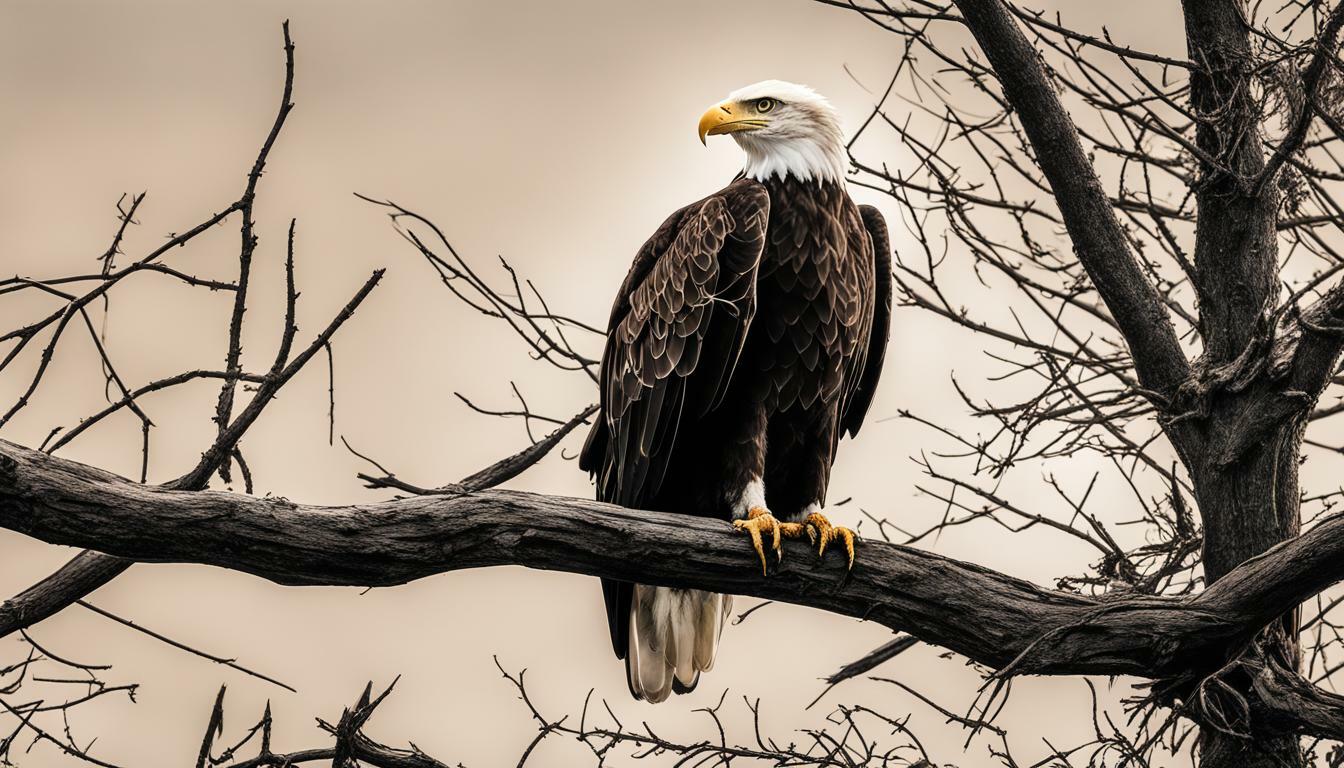As majestic creatures of the sky, eagles have long been revered for their impressive hunting skills and predatory prowess. But what do they really eat? While many people assume that eagles primarily prey on fish, the reality is that they have a much more diverse diet than you might think.
In this article, we will explore the predation habits of eagles, delving into their hunting behavior, food sources, and the factors that influence their dietary choices. We will also address the question that many pet owners may be wondering: do eagles eat cats?
Key Takeaways:
- Eagles have a varied diet and are apex predators in their ecosystem.
- Understanding eagle predation habits is important for conservation efforts.
- Eagle-cat interactions can occur, but factors such as habitat and territorial behaviors influence predation likelihood.
Understanding Eagle Predation Habits
As apex predators, eagles have developed sophisticated hunting behavior and rely on a variety of food sources to sustain their diet.
The predation habits of eagles are primarily influenced by their environment, prey availability, and territorial behavior. They are known to hunt both in the air and on the ground, using their sharp talons and powerful beaks to capture and kill their prey.
Eagles are opportunistic hunters and have been observed feeding on a wide range of animals, from fish and rodents to larger mammals like deer and goats. Their preferred prey, however, tends to be small to medium-sized mammals and birds.
When hunting, eagles exhibit a range of behaviors, from soaring high in the sky to stooping down to catch their prey. They may also grasp their prey mid-flight or pursue them on foot, depending on the circumstances.
One of the most distinctive features of eagle predation is their ability to store food for later consumption. Eagles have been observed caching their prey in trees or on the ground, allowing them to return to the food source at a later time when other prey is scarce or when they need to feed their offspring.
Overall, understanding eagle hunting behavior and their food sources is essential for gaining a greater appreciation of these magnificent birds and their role in maintaining ecological balance.
The Diet of Eagles
Eagles are apex predators and have a diverse diet, consuming a wide range of prey items. their diet may vary based on several factors, including their habitat, availability of prey, and hunting behavior.
Some of the most common prey items for eagles include small mammals, fish, reptiles, and birds. They are skilled hunters and can capture prey on land, in water, and even in the air. Eagles are opportunistic feeders and may also scavenge on carrion or steal food from other predators.
Diversity in the diet of eagles is crucial for their survival and overall health. Consuming a varied diet ensures that they receive the necessary nutrients and reduces the risk of potential health problems. For example, too much consumption of any one type of prey, such as fish, can result in toxicity due to mercury or other pollutants.
As birds of prey, eagles play an essential ecological role by helping to regulate populations of other animals. They are particularly important in maintaining balance among populations of small mammals and birds, which helps to preserve the health of ecosystems.
In conclusion, eagles have a diverse diet that may include small mammals, fish, reptiles, and birds. Diversity in diet is essential for their survival and good health. As apex predators, eagles play a crucial role in maintaining ecological balance.
Eagle Interactions with Cats
As apex predators, eagles have been known to hunt a variety of prey, including domestic cats. However, such interactions are relatively rare and depend on several factors.
Studies show that eagles may target cats living in or near their natural habitats, such as those in rural areas or near bodies of water. Additionally, cats may be more vulnerable to eagle predation if they are left outdoors unsupervised or are feral.
While some may view eagle-cat interactions as a threat to domestic cat populations, it is important to note that such predation is a natural occurrence in ecosystems. Evidence suggests that the impact of eagle predation on cat populations is relatively low and localized.
According to a study by the National Audubon Society, the predation of domestic cats by birds of prey accounts for less than 1% of cat deaths in the United States.
It is also worth noting that eagles play a crucial role in maintaining the balance of ecosystems and should not be viewed solely as a threat to domestic animals. Nevertheless, it is important for pet owners to take steps to reduce the risk of eagle predation, such as keeping cats indoors or supervised when outdoors.
Overall, while it is possible for eagles to prey on domestic cats, such interactions are not common and are influenced by various factors. It is important to maintain a balanced perspective on eagle predation habits and promote responsible pet ownership and wildlife conservation.
Factors Influencing Eagle-Cat Predation
While eagles do occasionally prey on cats, there are various factors that influence the likelihood of such interactions.
The availability of alternative prey items, for example, can greatly impact the likelihood of eagle-cat predation. If other prey, such as small mammals or birds, are abundant, eagles may be less likely to target cats as a food source. Additionally, habitat plays a role, as eagles are typically found in more open areas, while cats tend to frequent more urban or suburban environments.
Territorial behaviors also play a role in the frequency of eagle-cat interactions. Eagles are known to defend their territory from other predators, including cats, and may attack them if they perceive them as a threat.
It is important to note that while eagle predation on cats can occur, the impact on cat populations is typically minimal. Domestic cats are not a significant prey item for eagles, and their populations are not at risk from this behavior.
Overall, understanding the factors that influence eagle-cat predation can help promote coexistence between these animals and inform conservation efforts.
Other Prey Preferences of Eagles
Eagles are opportunistic predators and will consume a wide variety of prey, both vertebrates and invertebrates. Some of their preferred food sources include fish, rodents, rabbits, reptiles, and birds. Depending on their habitat and available food sources, eagles may also target larger mammals such as deer or even livestock.
One notable example of eagle adaptability is the golden eagle, which is known to hunt mountain goats and other large ungulates by ambushing them from above and causing them to fall from steep cliffs. Eagles are also known to scavenge carrion, especially during the winter months when food may be scarce.
Their diverse diet contributes to their ecological significance as apex predators, as they play a crucial role in controlling populations of prey animals and maintaining the health of ecosystems. However, as with any predator, their hunting habits must be balanced with conservation efforts and responsible management.
Conservation and Coexistence
Understanding the interactions between eagles and cats is critical to promoting coexistence and maintaining a healthy balance of wildlife and domestic animals. While eagles are known to prey on cats, it is important to consider the broader impacts of their hunting behavior on cat populations.
Responsible pet ownership plays a crucial role in mitigating the impact of eagle predation on cats. Keeping cats indoors or supervising them while outdoors can reduce their exposure to potential predators and promote their safety. Additionally, habitat conservation efforts can help to maintain healthy ecosystems and minimize the risk of cat predation by supporting the natural food sources of eagles.
It is also important to recognize the ecological significance of eagles as apex predators. As top predators, eagles play a critical role in regulating the populations of the animals they consume and maintaining the overall balance of their ecosystems. Thus, it is essential to find ways to foster coexistence between eagles and domestic animals in a way that supports the conservation of both.
Conclusion
In conclusion, the question “Do eagles eat cats?” is not a straightforward one. While there have been documented cases of eagles preying on cats, these interactions are not a common occurrence. Eagles typically prefer to hunt smaller mammals, birds, and fish, which make up the bulk of their diet.
It is important to understand that eagles play a crucial role in maintaining healthy ecosystems as apex predators. While they may occasionally prey on domestic animals, this should not be viewed as a reason for their persecution. Instead, responsible pet ownership and habitat conservation are essential for promoting coexistence between eagles and domestic animals.
In summary, the predation habits of eagles are complex and varied. While they may occasionally prey on cats, this behavior should not be viewed as a threat to domestic animal populations. By fostering harmony between wildlife and domestic animals, we can ensure the long-term survival of these fascinating birds of prey.
SEO keywords: Do Eagles Eat Cats
Are Worms Part of an Eagle’s Diet?
Eagles’ diet: debunking worm consumption. While worms are commonly associated with birds, eagles generally do not rely on them as a significant part of their diet. These majestic birds of prey prefer a diet consisting mainly of small mammals, fish, and birds. Worms may occasionally be consumed if they are present during scavenging, but they are not a primary food source for eagles.
FAQ
Q: Do eagles eat cats?
A: While eagles are known to prey on a variety of animals, including small mammals and birds, documented instances of eagles eating cats are rare. Eagles primarily target fish, waterfowl, and small prey found near water bodies.
Q: What do eagles typically eat?
A: Eagles have diverse diets that vary depending on the species and their habitat. They primarily consume fish, but they also feed on birds, small mammals, reptiles, and carrion.
Q: What factors influence eagle-cat predation?
A: The likelihood of eagles preying on cats is influenced by factors such as habitat, availability of other prey, and territorial behaviors. Cats that venture into eagle territory or are perceived as easy prey may be at a higher risk of predation.
Q: How can coexistence between eagles and cats be promoted?
A: Coexistence can be promoted by practicing responsible pet ownership, such as keeping cats indoors or supervised outdoors. Creating and maintaining suitable habitats for eagles and preserving natural prey sources can also contribute to peaceful coexistence.
Q: What is the ecological role of eagles?
A: Eagles play a crucial role as apex predators in their ecosystems. They help maintain a balance by controlling populations of their prey, contributing to the overall health and stability of the ecosystem.











